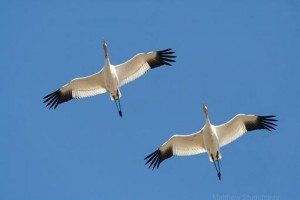by Ron Outen, Regional Director, The Aransas Project, Feb. 16, 2013
USFWS Releases 2012-2013 Whooping Crane Estimate
USFWS has posted their 2012-2013 Winter Whooping Crane Survey. USFWS estimates the flock size to be 257 birds using their new distance sampling method. This estimate does not reflect an actual count of the flock size, but instead offers a 95% probability that the actual flock size is somewhere between 178-362 birds.
flock size to be 257 birds using their new distance sampling method. This estimate does not reflect an actual count of the flock size, but instead offers a 95% probability that the actual flock size is somewhere between 178-362 birds.
TAP issued this statement by Regional Director Ron Outen in response to the release of the estimate: “With the new flock-estimation methodology, there will be no more actual counts of individual birds. By their own analysis, USFWS offers a 95% probability that the actual flock size is somewhere between 178-362 birds. TAP remains concerned that the level of uncertainty with this sampling method is unacceptably high for a population this size. Additionally, the method fails to locate territories or detect mortality—all valid concerns raised by former Whooping Crane Coordinator Tom Stehn.
More fundamentally, the community—both locally and internationally—has come to expect an accurate count of the cranes and flock size year to year on the wintering grounds. We urge that USFWS reinstitute an actual census of the cranes in addition to this new methodology until it can be further peer reviewed and refined to ensure accuracy.”
Shootings of Whooping Cranes Highlight Other Risks to Flock
Two recent articles highlight the variety of threats faced by whooping cranes, both as they migrate to and from the wintering grounds in and around Aransas National Wildlife Refuge and once they arrive.
The Whooping Crane Conservation Association recently posted a release from the U.S. Attorney’s Office, District of South Dakota, entitled “South Dakota Man Guilty of Whooping Crane Murder.” The release detailed the sentencing of a South Dakota man who pled guilty to the April 2012 killing of an adult male whooping crane. The release notes that:
“The whooping crane killed in this case was one of about 300 wild whooping cranes that migrate from wintering grounds along the gulf coast of Texas to the Wood Buffalo State Park located in Alberta and the Northwestern Territories of Canada. This population of whooping cranes is the only self-sustaining population in the world.”
The plea resulted in the man being sentence to $85,000 in restitution, 2 years of probation, a $25 assessment to the Victim Assistance Fund, forfeiture of the rifle used, and a 2-year ban from hunting, fishing or trapping.
Closer to home,it was recently reported that a duck hunter turned himself in to a game warden in Aransas County in connection with the accidental shooting of a juvenile whooping crane in January of this year on St. Joseph’s Island. According to the report, the hunter believe that the juvenile was a sandhill crane, and turned himself in when he discovered that it was a juvenile whooping crane.
Former Whooping Crane Coordinator Tom Stehn notes that the Aransas National Wildlife Refuge is in the process of opening the Matagorda Island marshes to waterfowl hunting, and suggests that perhaps hunters should be required to take an online identification course to better protect the whooping cranes.

